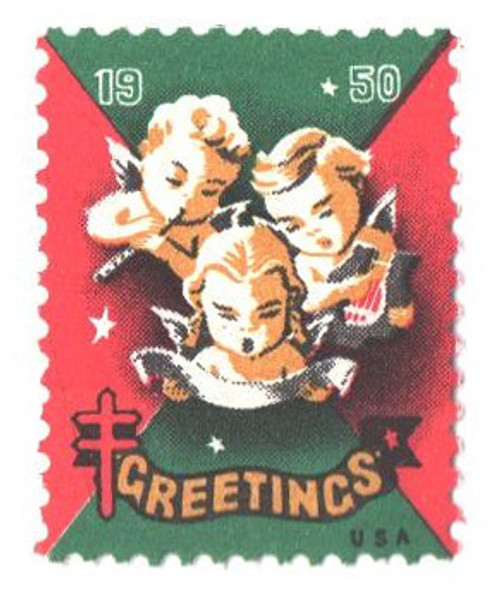
# WX140 - 1948 National Tuberculosis Assn. Christmas Seal - perf 12x 12 1/2
Christmas Seals Are Meaningful and Historic – Get Yours Now!
Why Collect Christmas Seals? Christmas Seals are fun to collect for all the same reasons we collect postage stamps. They're beautiful, have a neat backstory, and there's examples that'll fit any budget. Plus, they're festive and went toward a good cause...
Discover Their Story
In the early 1900s, tuberculosis was a major health concern across the globe. In 1904, Danish postal clerk Einar Holbøll came up with the idea of adding an extra stamp to holiday mail to raise money for tuberculosis research and patient care. The idea was approved and Denmark issued the world's first Christmas Seal that year. (It pictured Danish Queen Louise of Hesse-Hassel.) Other countries began following Denmark's lead not long after.
In 1907, American doctor Joseph Wales was facing the closing of his Delaware Tuberculosis Sanitarium. He contacted his cousin, Emily Bisell, who was the secretary of the Delaware Red Cross and an active member of the American Lung Association. Wales told Bissell that the sanitarium needed to raise $300 (nearly $9,000 today) or they would have to close their doors. Bisell had read about Denmark's Christmas Seals and thought introducing the idea to the United States would be a great way to help save her cousin's sanitarium.
Bissell designed the first US Christmas Seals and arranged for them to be printed on credit. The 1¢ seals first went on sale at Delaware post offices on December 7, 1907. The seals raised $25 on the first day, but sales quickly slowed down after that. Bissell responded by contacting North American newspaper in Philadelphia. They began selling the seals in their lobby and ran daily articles titled "Stamp Out Tuberculosis." President Theodore Roosevelt soon learned of the campaign and offered his support, bringing further attention to Dr. Wales' plight. By the end of the year, Christmas Seals had raised $3,000 – 10 times the amount of money needed to save the Delaware Sanitarium.
The next year, Christmas Seals went on sale at a national level, with millions printed. They raised $135,000 which provided aid to more tuberculosis sanitariums across the country.
The Red Cross continued to oversee the Christmas Seals program until 1920, when the National Tuberculosis Association took over. The NTA transformed Christmas Seals into the largest nonprofit direct mail campaign in the US. As tuberculosis became a more treatable disease, the program evolved, becoming the National Tuberculosis and Respiratory Disease Association from 1968-1972, and the American Lung Association from 1973 forward. Today, there are over 100 different lung associations around the world that issue Christmas Seals.
Christmas Seals Are Meaningful and Historic – Get Yours Now!
Why Collect Christmas Seals? Christmas Seals are fun to collect for all the same reasons we collect postage stamps. They're beautiful, have a neat backstory, and there's examples that'll fit any budget. Plus, they're festive and went toward a good cause...
Discover Their Story
In the early 1900s, tuberculosis was a major health concern across the globe. In 1904, Danish postal clerk Einar Holbøll came up with the idea of adding an extra stamp to holiday mail to raise money for tuberculosis research and patient care. The idea was approved and Denmark issued the world's first Christmas Seal that year. (It pictured Danish Queen Louise of Hesse-Hassel.) Other countries began following Denmark's lead not long after.
In 1907, American doctor Joseph Wales was facing the closing of his Delaware Tuberculosis Sanitarium. He contacted his cousin, Emily Bisell, who was the secretary of the Delaware Red Cross and an active member of the American Lung Association. Wales told Bissell that the sanitarium needed to raise $300 (nearly $9,000 today) or they would have to close their doors. Bisell had read about Denmark's Christmas Seals and thought introducing the idea to the United States would be a great way to help save her cousin's sanitarium.
Bissell designed the first US Christmas Seals and arranged for them to be printed on credit. The 1¢ seals first went on sale at Delaware post offices on December 7, 1907. The seals raised $25 on the first day, but sales quickly slowed down after that. Bissell responded by contacting North American newspaper in Philadelphia. They began selling the seals in their lobby and ran daily articles titled "Stamp Out Tuberculosis." President Theodore Roosevelt soon learned of the campaign and offered his support, bringing further attention to Dr. Wales' plight. By the end of the year, Christmas Seals had raised $3,000 – 10 times the amount of money needed to save the Delaware Sanitarium.
The next year, Christmas Seals went on sale at a national level, with millions printed. They raised $135,000 which provided aid to more tuberculosis sanitariums across the country.
The Red Cross continued to oversee the Christmas Seals program until 1920, when the National Tuberculosis Association took over. The NTA transformed Christmas Seals into the largest nonprofit direct mail campaign in the US. As tuberculosis became a more treatable disease, the program evolved, becoming the National Tuberculosis and Respiratory Disease Association from 1968-1972, and the American Lung Association from 1973 forward. Today, there are over 100 different lung associations around the world that issue Christmas Seals.












